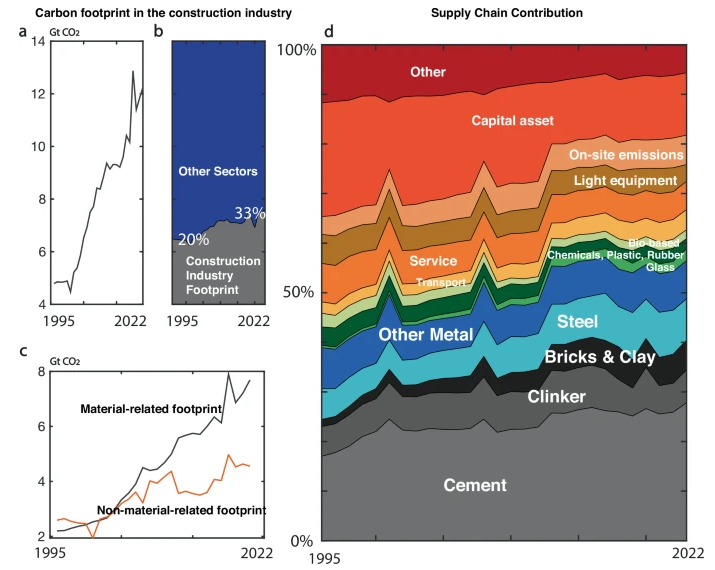Construction’s carbon footprint to double by 2050, study warns

A new global analysis published in Communications Earth & Environment warns that the construction sector’s carbon footprint has more than doubled since 1995, and, under current trends, is expected to double again by 2050. The study, reveals that construction now accounts for 33% of all global carbon emissions, up from 20% three decades ago. The increase is primarily driven by the rapid consumption of carbon-intensive materials such as cement, clinker, bricks, and steel, which together represent over half of the industry’s emissions. Cement alone contributes 28%, highlighting its dominance in the material mix.
By 2022, the sector’s total emissions reached 12.2 gigatons of CO₂, nearly seven times the 1995 level for key unsustainable materials. Emerging economies are now the main contributors, with China responsible for almost half of all construction-related emissions and India ranking second. The study warns that, even if all other sectors achieved net-zero, the construction industry alone could exceed the annual carbon budget for keeping global warming below 1.5°C as early as 2025, and for 2°C by around 2040. This trajectory underscores the urgency of systemic change, especially in fast-developing regions where population growth fuels infrastructure demand.

Researchers advocate for an accelerated transition toward low-carbon materials and production methods. Bio-based materials such as engineered timber, bamboo, and hempcrete, as well as cement alternatives like alkali-activated materials, could substantially lower embodied emissions if deployed at scale. However, large-scale adoption will require new machinery, supportive regulations, and certification systems that ensure sustainability without compromising structural integrity. The authors conclude that transforming the material base of construction is essential to meeting the Paris Agreement goals and that without decisive intervention, the sector will make these targets unattainable within decades.
Read the full article here.
Sources: nature.com, ccemagazine.com
Want to read more like this story?
The prospects for carbon-neutral buildings
Oct, 27, 2023 | NewsIn the United Kingdom, buildings account for 33% of greenhouse gas emissions and 40% of global ener...

17% carbon emissions reduction during COVID-19 lockdown
May, 19, 2020 | NewsAccording to a new study, global carbon emissions have been reduced by 17% during the lockdown follo...

Green Steel Production: The Future of Civil Engineering
Jun, 21, 2024 | NewsThe Importance of Steel in Modern Construction Steel is the backbone of contemporary construction,...

Concrete's Carbon Capture and Structural Longevity with Supercomputing
Oct, 08, 2025 | NewsResearchers at the University of Southern California have achieved a major milestone in material sc...

Carbon Reduction in Focus: Lessons from the Edge London Bridge Project
Jan, 20, 2025 | NewsA bold new addition to London’s skyline is taking shape near London Bridge. This 27-storey sustaina...

3D-printed buildings using soil material
Sep, 24, 2020 | NewsResearchers have developed a new technique to construct a building using a 3-D printer and soil mate...

Cementing Green Change: North Wales to Host First CCS Cement Facility
Apr, 25, 2025 | NewsThe UK has taken a major leap toward industrial decarbonisation with the approval of its first carb...

Scientists convert waste plastics into high-value carbon materials
Nov, 01, 2025 | NewsResearchers from Shenyang Agricultural University, the Guangzhou Institute of Energy Conversion (Ch...

New research on more efficient bridges
Jun, 01, 2020 | NewsA new study reveals the high potential of reducing the materials used in suspension bridge construct...
Trending

Vertical gardens in Mexico City to combat pollution

Characteristics of Load Bearing Masonry Construction

Taipei 101’s impressive tuned mass damper

Dutch greenhouses have revolutionized modern farming

Saudi Park Closed After 360 Big Pendulum Ride Crashes to Ground, 23 injured

King Salman Gate unveiled adjacent to Mecca’s Grand Mosque

The Line at Neom faces feasibility reassessment while construction continues

